Ancient Civilizations of the Inner Sea
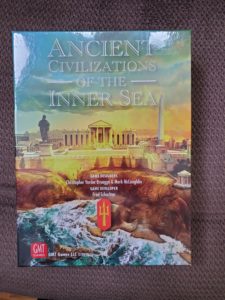
Publisher: GMT Games
Designers: Christopher Vorder Bruegge & Mark McLaughlin
Developer: Fred Schachter
MSRP: US$85.00
Overview: This is a hefty box with over 400 wooden pieces and 100+ cards. Although this game doesn’t have counters to punch, it does have seven pieces requiring a sticker placed on them. Upon counting all the pieces, (please do not judge me) I found extra pieces for each player color. This will really help out when the occasional piece eventually rolls away into the aether. The cards are of good quality and each one is unique and thematic. There are six player aides and one solitaire play guide. The player aides give a brief overview of each step with page numbers if you want to read the full rule. The solitaire play aide is the AI for the NPC. These guides are really useful in helping speed up the game while learning the game.
On first look you might think that this will be a conflict heavy game. Depending on your group this could be correct, but you can still win with only a few fights. It is more about managing your resources for points, instead of being the last one left alive. One good example of this, is how you control spaces. Every player can share a space as long as everyone has only one disc on a space. If you have 2 discs then you have a settlement and that grants growth for later turns. Once you have 3 discs in a space you have a city. Instead of growth, you earn victory points. It is important to balance earning points with the ability to grow and expand.
You can play this game solo or with up to a total of 6 players. Depending on the number of players and the scenario, the civilizations can differ from among a selection of 10. Each of the 10 cultures has a player board to store your pieces. It also instructs you on the civilization’s special abilities. These abilities range from being able to use the deep sea spaces early in the game to getting temporary discs to be used in a competition. The abilities are unique and themed to the culture. This helps each civilization to feel different.
The rulebook is 24 pages covering the basic setup for 2 to 6 players. The game is broken down into 4 phases. The growth phase allows you to place more of your discs and expand your empire. The card phase is where non-competition cards are played and wonders can be built. The third phase is the competition phase. A competition happens when an area has two or more discs belonging to one player and at least one disc belonging to another player. Competitions are abstract “fights” that involve removing discs or discarding cards in an effort to be the last one in the space. The final phase of a turn is the reckoning phase. This is a cleanup phase where players also check to see if an epoch ends early.
What is meant by “epoch” when it comes to this game? The game is broken down into four epochs. Each epoch is broken down into four turns. Each turn is made up of the four previously mentioned phases. A benefit of this breakdown is that if everyone so agrees, you can play for a set number of epochs and still have a full game. Maybe the group wants a quicker game and decides to only play one epoch. Or, perhaps they have an afternoon and want to spend it with a full four epoch game.
The playbook comes in at 60 pages. It is full of scenarios for all player counts and has the rules for solo play. The benefit of having this in a separate rulebook; is that you do not need to open it if you want to play the basic exploration game. When you have to play alone or you want to play any of the scenarios, then you can open up the playbook and choose one of the roughly 25 available.
I found that there are some unique rules that I really enjoyed and wanted to point out. The first is Aeneas step. This is part of the Reckoning step and it allows for a player to retire the civilization that they are currently using and pick another one to start playing. This gives someone who is doing very poorly a chance to come back in another part of the map. Another rule is the person in last place is responsible for resolution of the event cards. This can be used as a catch-up mechanic or for some chaos and fun.
I played a solo game from the playbook using the version 2 Fall of Rome II scenario. This had me playing the Western Romans vs the Visigoths. The other versions add the Eastern Romans and the Persians. I felt that using only half of the board would be easier for my first attempt at a solo game. That is why I picked half map version. In the solo play rules, there is an AI that has a tree to follow. This allows you to determine where the AI puts discs, and when and how they play cards. I found the tree a bit difficult to use when I got started. Having it printed out made it much easier to reference and follow. The AI will not be as smart or tricky as a real opponent, but it still managed to beat me.
Final Thoughts: I enjoyed my three plays of this game; and I plan on getting more games in with different (and more) people once we are able to gather in groups again. This game has plenty to think about, but you only have to manage one resource and your cards. This makes it pretty easy to get started and playing. If you come to the game looking to have fun while ancient volcanoes erupt and barbarians keep assaulting the map, then you should enjoy this. There may be a lot in the box, but it is not necessarily a heavy game.
I’d like to thank GMT Games for providing this review copy.

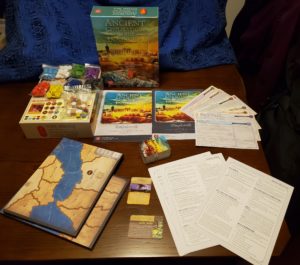
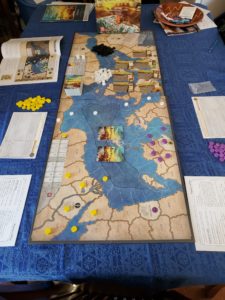
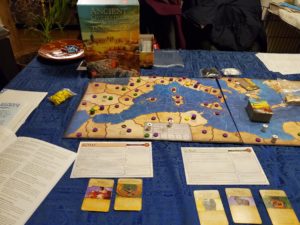
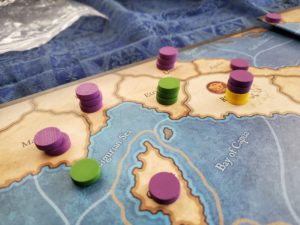


Nice review Robert! I had a copy of the game given to me by Carnage Con and GMT and Mark McLaughlin presented it to me! It’s a very cool game, Mark invited me to his house to try it out his copy and I’m very slow at picking up how to play something but felt I caught on well enough for my first time. I should be getting lots of repay with this one solo and in a group.